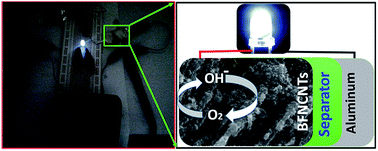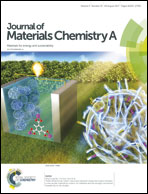Designing N-doped carbon nanotubes and Fe–Fe3C nanostructures co-embedded in B-doped mesoporous carbon as an enduring cathode electrocatalyst for metal–air batteries†
Abstract
Oxygen reduction and evolution reactions are of immense importance in electrochemical conversion/storage devices like regenerative/alcohol/hydrogen based fuel cells and metal–air batteries. Here, a rational facile synthesis methodology has been developed to design N-doped carbon nanotubes (N-CNTs) and Fe–Fe3C nanostructures co-embedded in B-doped mesoporous carbon nanostructures (BFNCNTs) as a noble metal-free superior bi-functional electrocatalyst for oxygen evolution/reduction reactions. The incorporation of N and B with negligible/undetectable B–N formation and Fe–Fe3C nanostructures leads to the superior performance by introducing plenty of defects, local heterogeneity and a high specific surface area (∼272 m2 g−1). Besides, mesoporous boron-doped carbon acts as a host material for NCNTs and Fe–Fe3C, and it offers good connectivity as well as a protective coating for durable catalysis. Remarkably, more positive onset (−30 mV) and half-wave potentials (−225 mV) with ∼94% current retention under accelerated stability test and fuel tolerance for the ORR, in combination with lower onset (422 mV) and Ej=10(OER) (562 mV) potentials with high current density (190 mA cm−2 @ 0.8 V vs. Ag/AgCl) for the OER as compared to commercial state-of-the-art electrocatalysts suggest superior bifunctional behavior of BFNCNTs. The complete oxygen electrochemical activity ΔE = Ej(OER)=10 − E1/2(ORR) = 0.788 V for BFNCNTs is lower than recently reported various state-of-the-art bifunctional catalysts. Besides, a prototype battery fabrication using BFNCNTs as the cathode electrode for driving a light emitting diode has been demonstrated. Overall, BFNCNTs have potential to serve as a non-precious electrocatalyst for electrochemical energy devices.



 Please wait while we load your content...
Please wait while we load your content...